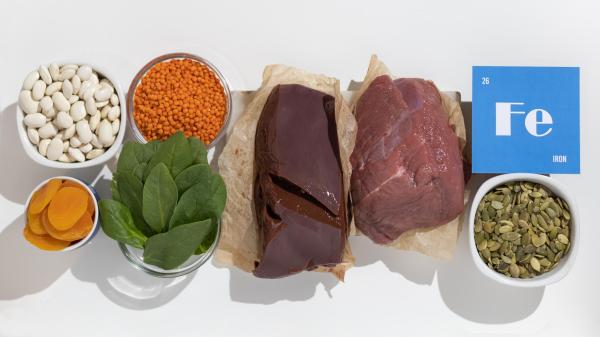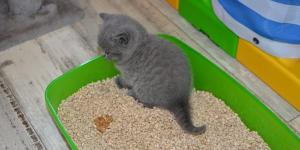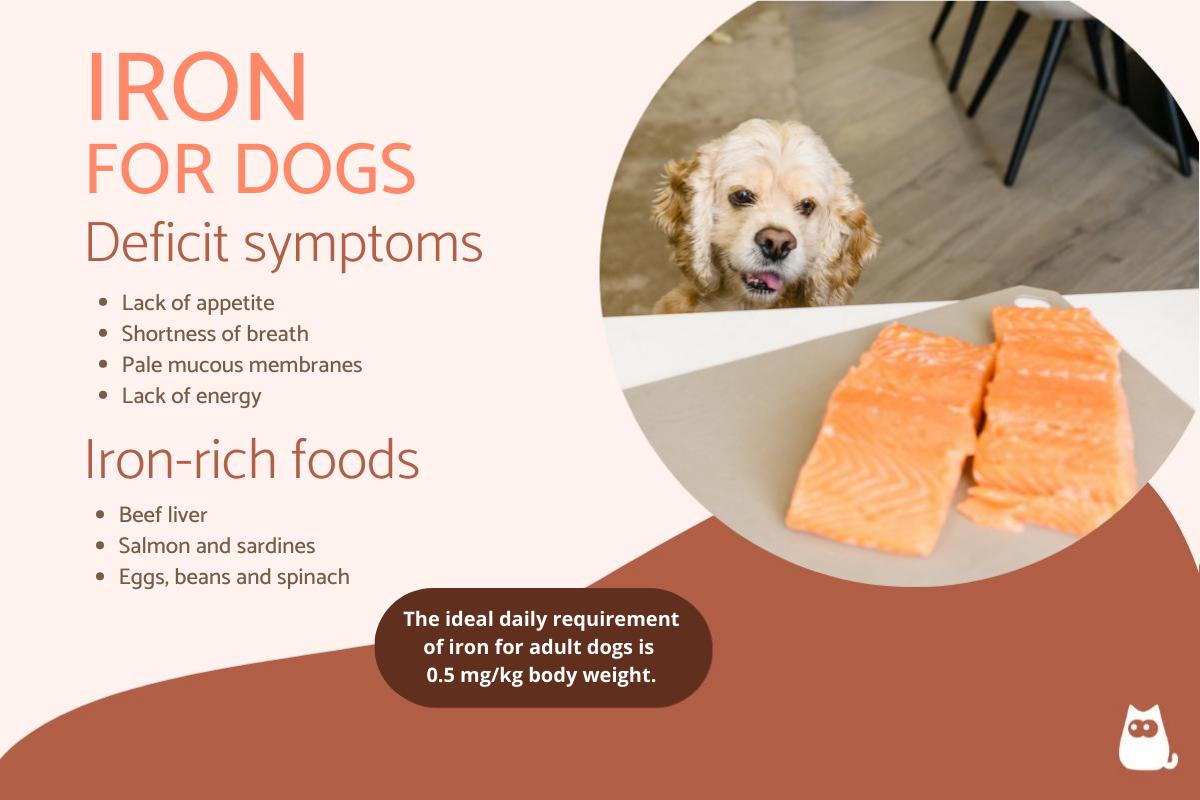Importance of Iron in Dogs



See files for Dogs
Iron is a mineral that your dog's body needs to perform important functions, such as transporting oxygen in the hemoglobin of red blood cells throughout the body. Unbalanced home-cooked food or even the cheapest food can lead to insufficient absorption of this mineral, causing the dog to suffer from anemia. Dogs with iron deficiency may be tired, listless, and reluctant to play, or show more severe symptoms such as shortness of breath and purple mucus. Caregivers should watch for signs of anemia and take the dog to the veterinarian as soon as they notice a change in behavior. Early treatment offers a better chance of a good prognosis.
The following AnimalWised article discusses the importance of iron, as well as the best iron-rich foods for dogs.
Why is iron important for dogs?
Iron is a vital mineral for the proper functioning of cells. It is essential for oxygen transport, synthesis of genetic material, and energy metabolism. Most of the iron in animals is found in erythrocytes (red blood cells) as hemoglobin.
In muscles, iron is contained in myoglobins, proteins that are responsible for oxygen transport, serve as a reservoir for this nutrient, and remove carbon dioxide from muscle tissue.
Iron consumed by the body is obtained from two main sources, food, and recycling of aged red blood cells.
Iron deficiency in dogs has consequences for the entire organism of the animal, anemia being the most important manifestation.
Causes and symptoms of iron deficiency in dogs
We have already said that anemia develops in dogs suffering from iron deficiency. The term anemia refers to a pathological process characterized by a decrease in red blood cells and/or hemoglobin.
Anemia is rarely a primary condition and is often the result of systemic disease. Therefore, it is important to know the cause of the dog's iron deficiency in order to initiate treatment that targets the primary culprit. Anemia may result from blood loss, which may be severe and rapid or slow and ¡chronic, and both may have different causes.
Causes of iron Deficiency in Dogs
Starting from acute bleeding, the causes may be the following:
- Trauma
- Gastrointestinal ulcers
- Coagulation disorders
The following causes may be responsible for chronic bleeding:
- Parasites (ticks, fleas, intestinal parasites)
- Gastrointestinal ulcers with slow bleeding
- Blood loss through the urine
- Bleeding tumors
In addition to blood loss, anemia may occur due to accelerated destruction of red blood cells and decreased production of these cells by the bone marrow, as in tick-borne disease. In this case, the causative agent of the disease, the bacterium Erliquia canis, transmitted by the tick Rhipicephalus sanguineus, causes the death of mature and immature cells in the bone marrow, resulting in low production of blood cells.
Anemia can also be caused by a nutrient deficiency called iron deficiency. It can occur in lactating animals because milk is an iron-deficient food. In these cases, young animals try to make up for the nutrient deficiency by eating dirt. However, in adult animals, the most common cause of iron deficiency anemia is chronic blood loss, usually through the gastrointestinal tract, in conjunction with iron malabsorption due to diseases such as gastritis, ulcers, and parasites.
Symptoms of a lack of iron in dogs
The most common symptoms of iron deficiency in dogs include:
- Pale mucous membranes
- Cyanosis
- Fatigue
- Respiratory problems
- Tachycardia
- Apathy
- Loss of appetite
If you notice any of these symptoms, be sure to talk to your trusted veterinarian about them. In most cases, the veterinarian will ask for a blood test to determine the dog's hematocrit level. The parameter is as follows:
- Mild anemia: between 37% and 26%
- Moderate anemia: between 25% and 13%
- Severe anemia: below 13%
In all these cases, iron should be supplemented and in the most severe cases, blood transfusion may be required.
For more information, see this other article, where we talk about nutrition and care for dogs with anemia.
How to treat iron deficiency in dogs?
Iron can be supplied to dogs in two ways: by diet or intravenously.
In the first case, diet plays an important role, as the puppy or adult dog must consume foods with a high content of this mineral. In addition, iron can be supplied through dietary supplements such as tablets or oral solutions, which are readily available in pet stores.
Intravenous administration of iron is indicated in the most severe cases of iron deficiency and should be prescribed by a veterinarian.
Ideal iron dosage in dogs
If your dog needs to take an iron supplement, the dosage will depend entirely on the degree of deficiency as well as the supplement used. Therefore, the veterinarian should determine the appropriate dose, as excess iron in dogs can also be harmful.
However, as a rule of thumb, the recommended daily requirement of iron for adult dogs is 0.5 mg/kg body weight. This requirement is somewhat higher for growing and nursing puppies due to their rapid growth rate.
Iron-rich foods for dogs
Like people with iron deficiency anemia, dogs can also benefit from an iron-rich diet. Healthy dogs usually get all the iron they need from their dog food, but other food sources contain plenty of iron, these include:
- Salmon and Sardines: both are iron-rich fish that can be offered to dogs with their food or as a snack. They can be boiled, steamed or grilled, always without bones.
- Beef: red meat can be given to dogs mixed with a carbohydrate source (rice or mashed potatoes) and a fiber source (carrots, oats, or brown rice). Always remember to offer cooked or grilled meat to avoid disease transmission.
- Beans or spinach: they are rich in iron and a perfect complement to other foods of animal origin. They should also be boiled or steamed.
- Eggs: not only are they high in protein, but they are also a natural source of vitamin B12. They must be well cooked to avoid the transmission of diseases such as salmonellosis. Another iron-rich food that is very popular with dogs is egg yolk, which can be cooked and added to the normal diet.
- Fruit is an excellent source of vitamin C, which aids in the absorption of iron. If your dog likes mango, tomato or strawberry, you can offer them these fruits in the form of snacks or in combination with the aforementioned ingredients.
You may also be interested in this other article, where we talk about iron-rich foods for cats to increase red blood cells.

Is it good to give dogs liver to raise iron levels?
Beef liver is a classic in the diet of dogs with anemia, which means that it is one of the most recommended foods for them. This is because this organ is rich in iron, vitamin B12 and folic acid, nutrients that the bone marrow needs to form red blood cells.
The liver can be offered to the dog raw, cooked or dehydrated (lyophilized). In the first case, you must take special care to use a well-preserved, fresh and parasite-free piece that you freeze and thaw beforehand. When cooked, it can be offered to the animal as a meal or as a snack. In dried form, you can find liver in the form of fillets at specialty pet supply stores. Remember that liver should always be offered in small quantities due to its high fat content.
Prohibited foods for a dog with a lack of iron
You have already seen which foods for dogs are rich in iron. However, it is important to know that there are some foods that you should avoid if your dog is iron deficient. These are:
- Onion: contains an element called n-propyldisulfite, which is toxic to dogs. This substance causes the conversion of hemoglobin to methemoglobin, which impairs oxygen transport to tissues. Symptoms include listlessness, fatigue, tachycardia, shortness of breath and cyanosis.
- Milk: should be avoided immediately after meals because it contains high levels of calcium, which competes with iron for absorption by the body. The occurrence of anemia is possible in puppies that are only suckling.
- Beans: are rich in zinc, a nutrient that competes with iron in the absorption phase. Therefore, it is not recommended to combine beans with other iron-rich foods for dogs, such as red meat and liver.
You may also be interested in this other article where we talk about forbidden food for dogs.
This article is purely informative. AnimalWised does not have the authority to prescribe any veterinary treatment or create a diagnosis. We invite you to take your pet to the veterinarian if they are suffering from any condition or pain.
If you want to read similar articles to Importance of Iron in Dogs, we recommend you visit our Home Remedies category.
- Grotto, HZW Iron metabolism: a review of the main mechanisms involved in its homeostasis . Rev. Bras. hematol. Hemoter, 2008. Available at https://www.scielo.br/j/rbhh/a/HLcTcgqkgV7VmpRWyWTTVXw/?lang=pt.
- Lopes, FB et al . Allium cepaem poisoning in small animals – Literature review. XVII Inter-institutional Seminar on Teaching, Research and Extension. Unicross. Available at https://home.unicruz.edu.br/seminario/downloads/anais/ccs/intoxicacao%20por%20allium%20cepaem%20pequenos%20animais%20%E2%80%93%20revisao%20bibliografica.pdf.
- Drumond, MRS (2013). Occurrence, classification, and risk factors of anemia in dogs . Federal University of Viçosa. Available at https://www.locus.ufv.br/bitstream/123456789/5160/1/texto%20completo.pdf.
- Alencar, NX et al . (2022). Iron metabolism in domestic animals: review . Continuing Education Magazine. Available at file:///C:/Users/alvar/Downloads/3274-Texto%20do%20article-2753-1-10-20130826.pdf.






